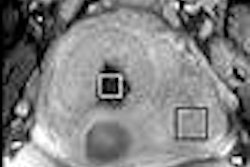(Radiology Review) Chest MRI with a 2D half-Fourier acquisition single-shot turbo spin-echo (HASTE) sequence can detect, exclude, or monitor lung lesions 5 mm or greater, according to radiologists at University Hospital in Essen, Germany. To date, use of MRI of the lungs has been limited by poor spatial resolution, "high susceptibility differences between air spaces and pulmonary interstitium, and the presence of respiratory and cardiac motion artifacts," according to Dr. Tobias Schroeder and colleagues.
In the October issue of the American Journal of Roentgenology, the researchers stated that while CT was the modality of choice, CT was "inherently associated with sometimes considerable levels of exposure to ionizing radiation and the potential of nephrotoxicity when contrast agents are applied." Screening programs aimed at reducing the high incidence of primary and secondary pulmonary malignancies have motivated researchers to find a suitable alternative to CT, they wrote.
Both MRI and CT examinations were performed on 30 patients with known pulmonary nodules, and four-slice MDCT was used as the standard of reference. "MRI was performed with axial and coronal HASTE sequences using a high-performance 1.5-tesla MR scanner," they wrote. First, a full analysis of all CT image data was performed; second, all the MR image data were reviewed without knowledge of CT findings; and third, corresponding CT and MRI data were analyzed including a "one-to-one correlation of the size and location of all the nodules that were detected."
The results showed that the HASTE MR sequence had a sensitivity of 73% for lesions less than 3 mm, 86.3% for lesions 3-5 mm, 95.7% for lesions 6-10 mm, and 100% for lesions larger than 10 mm. Therefore, the overall sensitivity of the HASTE MR sequence for detecting all pulmonary lesions was 85.4%.
A comparison of CT and MRI spatial resolution demonstrated that CT was far superior. MR 2D HASTE sequence in-plane resolution was limited to 1.3 x 2.4 mm. "Some experts suggest that lesions should exceed 5-7 mm for follow-up to be cost-effective, even though this approach is controversial," the authors wrote. Therefore, there may be a place for MRI with HASTE sequence in screening programs. They recommended that when a suspicious lesion was 5 mm or smaller on lung MRI, then CT evaluation should also be performed.
"Detection of Pulmonary Nodules Using a 2D HASTE MR Sequence: Comparison with MDCT"
Tobias Schroeder et al
Department of Diagnostic and Interventional Radiology, University Hospital Essen
Hufelandstrasse 55, Essen 45122, Germany
AJR 2005 (October); 185:979-984
By Radiology Review
October 13, 2005
Copyright © 2005 AuntMinnie.com


.fFmgij6Hin.png?auto=compress%2Cformat&fit=crop&h=100&q=70&w=100)





.fFmgij6Hin.png?auto=compress%2Cformat&fit=crop&h=167&q=70&w=250)











